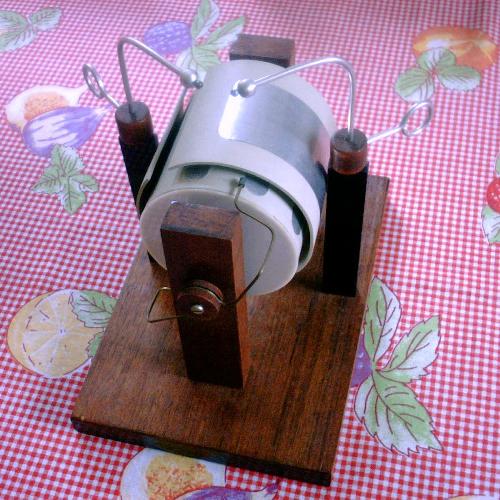

By January 1997, I built a small simplified Voss machine using sections of 3.5" PVC tube. The structure is identical to a Lord Kelvin's "replenisher", with the tubes providing better insulation. The structure is also similar to A. D. Moore's "Dirod" machine, but with flat plates instead of rods. Actually, a more proper name to this structure would be "Belli machine", since Belli was the first to make a machine in this form, by 1831.
The internal cylinder is a section of PVC tube closed at both ends with acrylic disks, fixed to a steel axle with the help of two small wood cylinders at the ends and glue. At the external surface of this cylinder, 8 strips of aluminum foil are glued. The axle crosses one of the two supports, and is turned by a small pulley connected to a larger pulley with a crank.
The external cylinder is made of two sections of the same tube, cut in two and deformed to a smaller curvature by heat (a hair dryer). At the outer side of the sections, aluminum foil inductors are glued. The sections of the external cylinder are fixed by small screws to two acrylic insulating supports. The screws also fix brushes of thin wire that touch the sectors in the internal cylinder, connecting them to the inductors.
A neutralizer wire with thin wire brushes short-circuits opposite sectors in the rotating cylinder when they are leaving the influence of the inductor plates. It is fixed in a wood piece screwed to the support opposite to the driving pulleys, and can have its position adjusted. All the four brushes are of fine nickel-chrome wire, taken from a high value wire-wound resistor. The inductor brushes are formed by some wires wrapped in a metallic washer at the outer side of the inductors, between them and the supports. The wires pass through the holes of the screws that fix the inductors. The neutralizer brushes are fixed by sections of rubber wire insulation.
Two terminals connected to the inductors (they touch the screws that fix the inductors and brushes in holes in the supports) complete the machine.
The machine produces sparks 3 cm long. Not bad for the ~9 cm diameter of the rotating cylinder. Polarity inversions occur frequently, due to charge accumulation in the inner side of the inductors (aggravated by the sectors put in the outer side of the rotating cylinder). Better performance could be obtained if the internal side of the internal cylinder were used for the sectors, and if greater distances were used between the charged parts and the wood support.
Created: 28/2/1997
Last update: 18/1/2004
By Antonio Carlos M. de Queiroz
Return to Electrostatic Machines